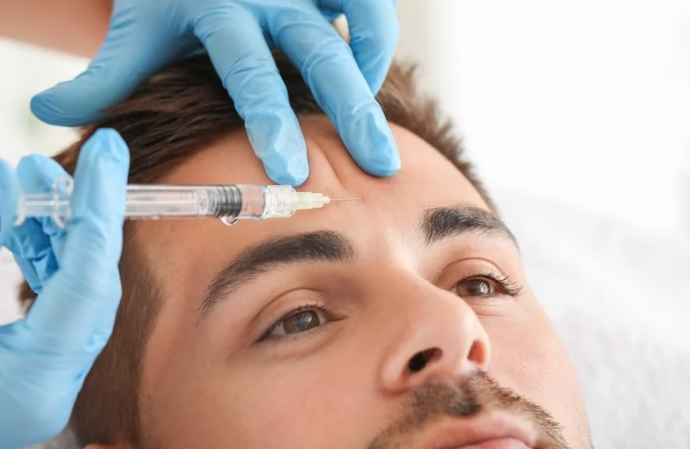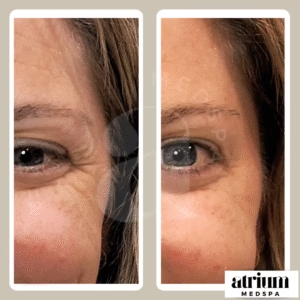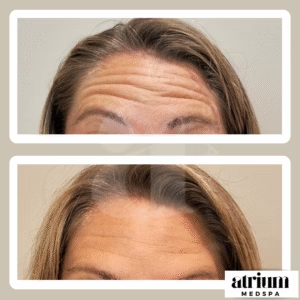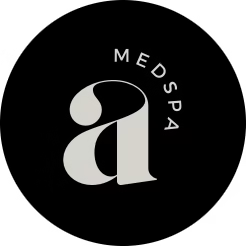
BOTOX® (onabotulinumtoxinA)
The original, tried-and-true wrinkle relaxer.
As we age, our skin naturally loses elasticity and volume due to factors like decreased collagen production, repeated facial expressions, sun exposure, and gravity. Muscle contractions beneath the skin cause dynamic wrinkles (lines that deepen when you frown, smile, or squint). These fine lines, especially around the forehead, between the eyebrows, and around the eyes, become more noticeable over time and contribute to an aged appearance.
What Botox Is and How It Works
Botox is a brand name for a type of toxin produced by the bacteria Clostridium botulinum; the toxin is called botulinum toxin, which is where Botox gets its name. Injected in very small, controlled doses, Botox works by blocking nerve signals that tell muscles to contract. This temporary muscle paralysis relaxes muscles so they cannot tighten and cause wrinkles. Botox typically begins to take effect within a few days, with maximum effect appearing at approximately 2 weeks. The effects last about 3 to 4 months before the muscle action gradually returns.
What Does Botox Treat?
Cosmetic Uses
Botox is widely used to reduce the appearance of dynamic wrinkles, fine lines, and other concerns, including:
- Frown lines between the eyebrows (glabellar lines)
- Horizontal forehead lines
- Crow’s feet around the eyes
- Wrinkles between the eyes and the bridge of the nose when squinting or scowling (bunny lines)
- An upper lip that disappears when smiling (lip flip)
- Exposing too much of the upper gums when smiling (gummy smile)
- Lifting the corners of the mouth (DAOs or Marionette lines)
- Wrinkles on the chin and neck
It can also soften facial features by relaxing thick jaw (masseter) muscles, improve uneven smiles, and enhance overall skin texture.


Medical Uses
Beyond cosmetic purposes, Botox is FDA-approved and commonly used to treat various medical conditions such as:
- Excessive sweating (hyperhidrosis), particularly in the underarm region
- Chronic migraines
- Temporomandibular Joint Disorder (TMJ), which causes jaw muscle pain and dysfunction.
The Procedure and Comfort
Before the Procedure
When you book a Botox appointment, we will review your medical history and current medications to ensure your safety and reduce bleeding or bruising risk. Then we’ll perform a full consultation, making sure to evaluate any fine lines, wrinkles and trouble spots, and to make sure that the treatment is right for you.
During the Procedure
Botox is injected with a very fine needle into specific muscles or skin areas based on your treatment goals. Multiple small injections are usually needed. The procedure usually takes about 10 to 30 minutes and does not require anesthesia. Most people feel only mild discomfort, often described as a slight pinch or sting; numbing is usually not necessary, but can be provided with ice or a topical cream if needed. Most patients tolerate the procedure well.
Aftercare
Avoid lying down or rubbing the treated areas for several hours to let Botox settle properly. You can resume normal activities immediately with minimal restrictions.
Results typically appear within 3 to 7 days, and full treatment effect is seen at approximately 2 weeks. For this reason, we’ll usually schedule a short follow-up appointment with you 2 weeks after your Botox injection, to make sure that the intended effect is seen, and to perform any touch-ups that are needed. The effects of Botox last approximately 3 to 4 months, after which repeat treatments may be desired to maintain the effect.
In summary, Botox is a safe, minimally invasive treatment that can effectively reduce facial wrinkles, improve some medical conditions, and is generally well tolerated. It offers a fresh, natural look without surgery and with minimal downtime.
Side Effects and Common Patient Concerns
While Botox is generally safe and well tolerated, patients may experience some side effects and have concerns about the treatment. The most common side effects include mild pain, swelling, or bruising at the injection site, which usually resolve quickly. Some people may notice headaches, droopy eyelids or eyebrows, dry eyes, or flu-like symptoms such as tiredness. These effects are typically temporary and manageable.
More serious but rare side effects can include muscle weakness beyond the injection area, difficulty swallowing or breathing, allergic reactions such as rash or swelling, and asymmetry if the injections are uneven. It is also possible to develop resistance to Botox over time, reducing its effectiveness.
To minimize risks, injection by a skilled provider, careful attention to medical history, and following aftercare instructions like avoiding rubbing the treated area are important. If any concerning symptoms occur—especially breathing or swallowing difficulties or severe allergic reactions—immediate medical attention is necessary. Overall, most patients tolerate Botox well and find the side effects mild and temporary.
Questions about Botox?
Ready to learn more or see if Botox is right for you? If you have questions or want to discuss your goals, don’t hesitate to reach out. Scheduling a consultation is the best way to get personalized information and feel confident about your treatment options. Call today or book an appointment online to take the next step toward a refreshed, natural look and improved well-being. We’re here to help you every step of the way!

